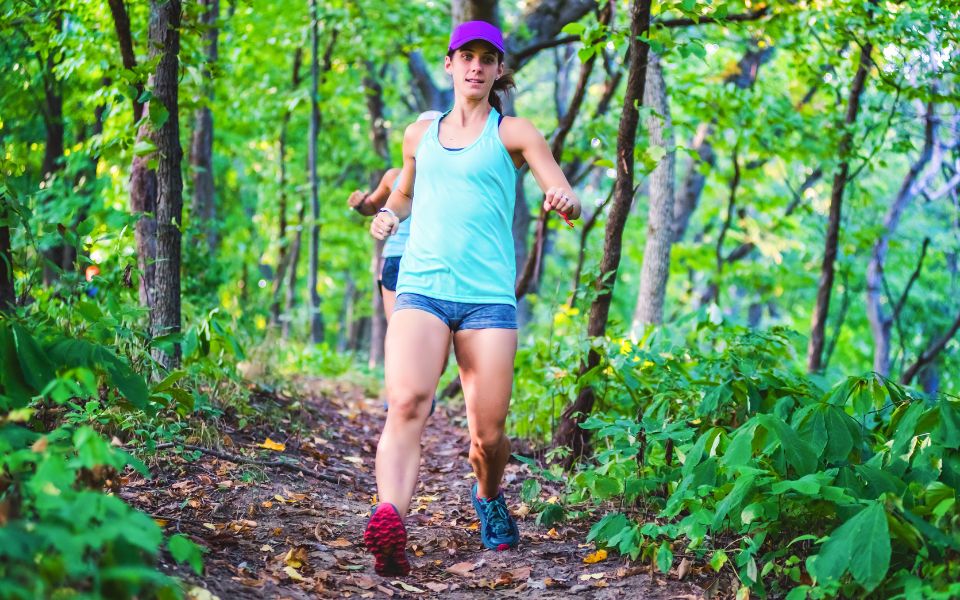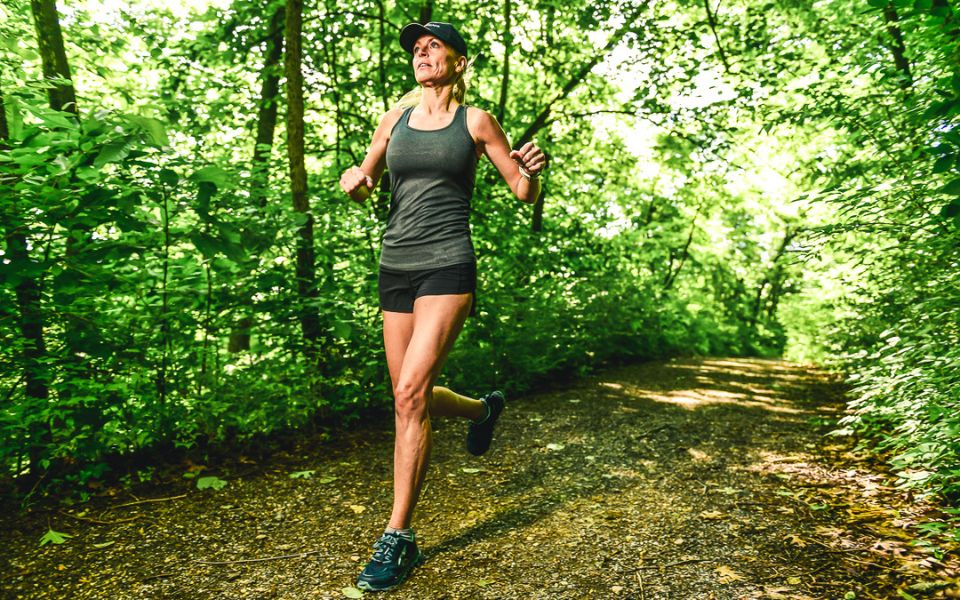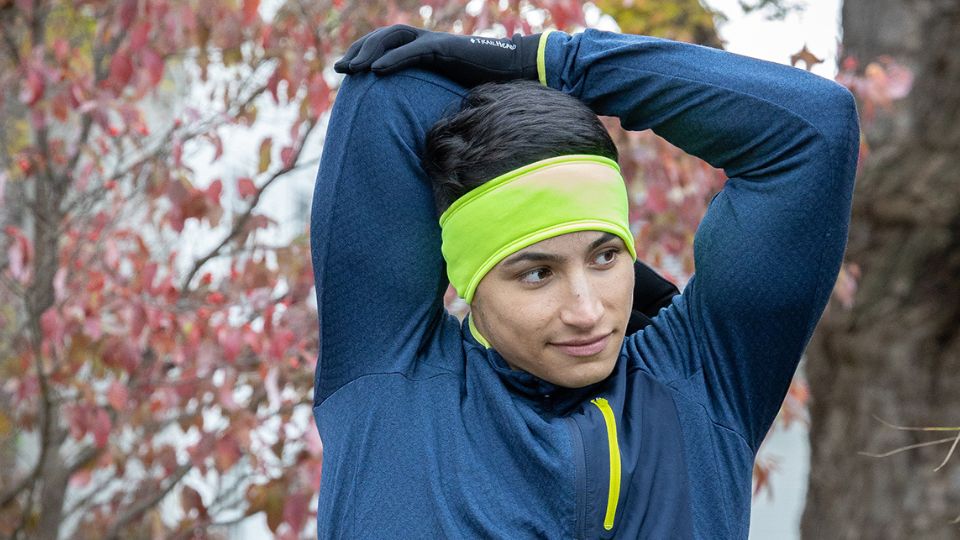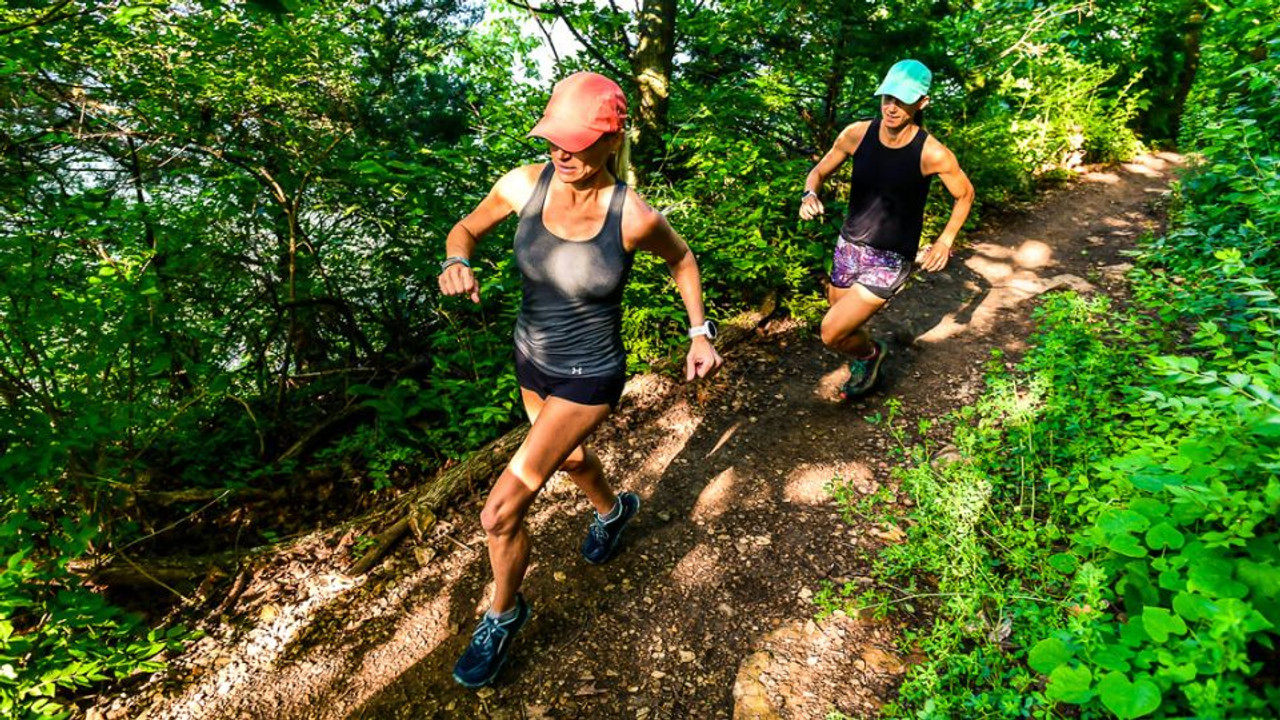The key to comfort for trail running is dressing in smart layers.
Figuring out trail running gear can feel daunting, regardless of your experience level, but fear not. If you like road running and hiking, most apparel and gear used for those activities can be repurposed for trail running. If you’re starting a trail running wardrobe from scratch, selecting high-quality items that can transition through seasons is key.
Naturally, the right footwear will go a long way in comfort and performance. Investing in a pair of trail running shoes will help prevent slipping on uneven terrain. Your trail running clothes should include moisture-wicking materials, such as synthetic fabrics or Merino wool. Dressing in layers will help, especially on longer runs where the conditions can change in an instant. Having apparel with pockets—or a hydration vest—to stash layers, water and snacks will make your adventure much more enjoyable.
Differing temperatures and conditions across seasons will affect how you gear up for a run. This guide includes the best trail running gear and our handpicked list of must-have running accessories for every season to make trail running fun and comfortable year-round.
Layering up for winter trail running

Trail running doesn’t have to stop just because temperatures are frosty and snow is on the ground. In fact, breaking trail through fresh snow can be quite fun! The perfect winter trail running kit includes a moisture-wicking base layer, an insulating layer and a wind/rain layer.
Remember, cotton kills because it tends to hold moisture close to the body, which can cause your core temperature to drop. High-performance synthetic materials, lightweight fleece and Merino wool are popular fabrics for winter running. Synthetic down is an excellent insulating material because it can get wet and still do its job to keep you warm. Avoid animal downs. They don’t perform well when they get wet. A wind- and water-resistant layer will add protection on windy and snowy days.
Top your outfit off with a cozy hat and a pair of gloves. We recommend the Merino Wool Ponytail Hat for Women because Merino wool insulates and keeps body parts warm when it’s wet. Our Trailblazer Hat is the perfect running hat for men. It features reflective details for added visibility in the dark. The best part? The built-in fleece ear band easily folds up when you don’t need it and flips down when the wind kicks up and your ears need extra protection.
To keep hands toasty warm, we recommend the Convertible Zip Mitts for men and women. They’re stuffed with Primaloft insulation to trap in warmth and feature a zippered access to free your fingers or get some fresh air circulating without taking the gloves off.
Hot tip: Many runners dress for 10-20 degrees different than outside temps to account for the body heat generated while running. So, on a 30-degree day, dressing as if it’s 40-50 degrees will ensure you’re not overdressed, helping prevent overheating and too much sweating. It does make for a somewhat chilly start, but a proper, pre-run warmup can help.
Spring showers and smart trail-running layers

Chilly temps remain in early spring, so hanging onto those insulated layers is a great idea. As the season transitions towards summer, running in the rain becomes a solid possibility. A packable, water-resistant jacket will be helpful to prevent getting soaked on your trail run.
Hot tip: It’s best to avoid fully waterproof fabrics with sealed seams. Because they’re designed to keep water out, they are also pretty good at trapping sweat on the inside. If you’re going to get soaked with sweat inside your jacket while it rains outside, why bother, right?
A lightweight, brimmed hat like the Race Day Men’s Running Hat and Race Day Women’s Running Hat will help keep the rain out of your eyes, and a thin pair of running gloves will help keep hands warm when temps and conditions are on the raw side earlier in the season.
Your base layers and socks can stay the same in spring conditions, but get ready for mud! Unless trails are closed for mud season, it’s always best to run right through it instead of going around. Avoiding mud causes erosion that widens the trail and sometimes results in “social trails,” and both damage fragile ecosystems. So, embrace your inner child and play in the puddles unless otherwise directed by your local parks department.
Trail running in summer sun and heat

Lightweight, breathable and moisture-wicking are where it’s at for trail running in summer months. Light colors will reflect the sun, and look for details like mesh or laser cutting to enhance the breathability of your apparel.
Hot tip: If you can, incorporate UPF apparel into your wardrobe to protect your skin from the sun’s harmful rays. It’s a nice alternative to bringing sunscreen if you don’t want to carry the extra weight.
Bonus hot tip: If you put your moisture-wicking apparel in the dryer (by accident or on purpose—no judgment), avoid using dryer sheets. The wax on the sheets transfers to clothing to prevent static, but it also prevents the fabric from pulling moisture to the surface where it can evaporate.
Don’t forget a pair of UV-protective sunglasses and a brimmed hat to protect your eyes and face. After all, UV rays can damage the eyes. We love the Women's UV Protection Hat for summer trail runs because it’s made with a lightweight fabric that is moisture-wicking and quick-drying. It comes in multiple colors, making it a cinch to match your hat to your outfit, and the dark underbill reduces glare so you can keep focused on the trail ahead. The UV Protection Hat also comes in men’s sizing and features different colors.
Trail running in fall through time changes and dropping temps

If you’re fortunate enough to be able to run from your front door to a trailhead, keep in mind the potential hazards of passing cars, especially during dawn, dusk and dark hours. For that reason, ensuring you’re wearing bright colors and reflective gear is essential for safety.
Hot tip: A running kit should include a headlamp. Your headlamp lights your way and makes you more visible to oncoming cars and other runners. 300 lumens should be sufficient to light up any obstacles on the trail.
When temps start to drop, keeping your hands warm will help keep your whole body warm. There’s a common misconception that all body heat escapes through your head, but the truth is any exposed body part will lose heat, including your hands. We recommend the Men’s Convertible Running Gloves so you can easily alternate between gloves and mittens depending on the temperature. These Convertible Running Gloves come in women’s sizes, too!
Adding a headband will help keep ears from getting cold. We love the Winter Running Headband for fall and winter trail runs. This moisture-wicking headband features a contoured fit for full ear protection.
Trail running is fun year-round. Each season presents challenges, but those are easy to overcome with the right gear.Check out our full assortment of TrailHeads for all your running needs so you can take the trail less traveled.
The Difference Between Regular Running Gear and Trail Running Gear
Trail running gear differs from regular running gear mainly because the conditions and terrain are so different between the two. Unlike road running, a trail features uneven ground, mud, rocks, hills, and other elements that challenge you (that’s part of the fun!). You need sturdy trail shoes built to hold up under those conditions and provide greater traction and support.
Lightweight, breathable clothing layers are the way to go in any weather, but since conditions can change fast on the trail, a waterproof running jacket keeps out the chill or a sudden downpour and sunglasses are a must in any season. It’s also a good idea to have bright colors (like hunter orange) and reflective accents on your hat, jacket, or running vest in order to be spotted by others in the woods, such as hunters.
Trail Running Gear Checklist
If you’re a runner who wants to try their hand at trail running, some of your existing running apparel (like a hat, sunglasses, or jacket) may work just fine. But to get the most out of the sport and perform at your best, it’s worth it to invest in specific trail running gear, especially shoes designed for trails. Here’s your essential trail running gear list.
- Trail Running Clothes
- Trail Running Shoes
- Trail Running Socks
- Running Gloves
- Running Gaiters
- Trail Running Jackets
- Running Sunglasses
- Trail Running Hats
- Running Hydration Packs
- First Aid Kit
- Trail Running Accessories
Trail clothes should be lightweight, moisture-wicking, and breathable. In cold months, a headband keeps ears warm, and gloves help retain body heat. A hat at any time of year keeps the sun out of your eyes. A lightweight, waterproof jacket averts rain or wind; bright colors and reflective accents, like those on a running vest, make you easier to spot. If you are running during hunting season it’s important to wear some hunter orange to stay safe on the trails.
Trail running shoes differ from road running shoes because they’re designed to handle uneven terrain. A trail runner needs a shoe with soft lugs for better stability and traction, whereas running shoes have flatter soles suited to smooth pavement.
Running socks for the trail are meant to handle mud and water. They need to be moisture-wicking to keep feet dry and healthy and are often made from anti-microbial Merino wool. Trail running socks are higher on the ankle to help prevent scratches from debris on the path.
You don’t lose body warmth only from your head! A pair of lightweight running gloves keeps your hands warm and can help retain more of your body heat overall.
Running gaiters attach to your shoes to keep pebbles, sand, and debris from getting inside and causing irritation. They also protect your lower legs from scratches if you’re running in areas with heavy brush or a lot of sand.
A jacket for the trail needs to be lightweight, waterproof, and wind-resistant. Even though it’s light, a running jacket should keep in your body warmth but be breathable so that your sweat evaporates from your skin. It’s also good to have reflective accents to keep you visible.
Running sunglasses are designed to fit securely and feature lenses that don’t just protect eyes from UV rays, but reduce glare on the trail. They’re also built to be extra-durable. Some pairs even feature vents to keep them from fogging up.
A trail-running hat shields your eyes from the sun and helps protect you against rain and wind. It helps regulate your body temperature in any season and keeps sweat from running into your eyes. It’s also a way to keep hair out of your face, especially if you choose a hat that can comfortably accommodate a ponytail. Plus, wearing a hat during a trail run helps you avoid distractions and maintain your focus.
One of the most important things in running is staying hydrated. This is especially true in endurance-heavy trail races. A lightweight running hydration vest allows you to carry and access your beverages hands-free and never miss a step. You can even find a hydration pack that lets you stash accessories like sunglasses, lip balm, even an extra layer. When you take your trail running up a notch, a running hydration pack is something you won’t want to be without.
A simple first aid kit is a must to add to your trail running gear. Think in terms of what you would need to treat a cut, blister, sprain, or muscle strain. Bring along different types of bandages, wipes, and wraps for support. There are many pre-made first aid kits that are easy to carry.
There are a few other accessories that come in handy for trail running. A headlamp can light the way, especially if you run in the early morning or at dusk. A GPS watch (with a fully-charged battery), extra pair of trail running socks, and a small knife will prove useful more often than you think. For safety, a whistle and pepper spray is good to have as well.
Conclusion
Trail running offers many benefits over regular road running. You’re out in nature, it’s not as crowded, and the physical challenges can be exhilarating. With the right gear, you can fully enjoy it, and stay safe and healthy.

